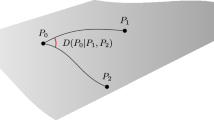Abstract
This paper describes semantic communication as an arbitrary loss function. I reject the logical approach to semantic information theory described by Carnap, Bar-Hillel and Floridi, which assumes that semantic information is a logical function of Shannon information mixed with categorical objects. Instead, I follow Hirotugu Akaike’s maximum entropy approach to model semantic communication as a choice of loss. The semantic relationship between a thing and a message about the thing is modelled as the loss of information that results in the impression contained in the message, so that the semantic meaning of a bear’s footprint is the difference between the actual bear and its footprint. Experience has a critical function in semantic meaning because a bear footprint can only be meaningful if we have some experience with an actual bear. The more direct our experience, the more vivid the footprint will appear. In this model, what is important is not the logic of the categories represented by the information but the loss of information that reduces our experiences of reality to functional communication. The hard problem of semantic communication arises because real objects and events do not come with categorical labels attached, so the choice of loss is necessarily imperfect and illogical.
Similar content being viewed by others
References
Akaike, H. (1974). A New Look at the Statistical Model Identification. IEEE Transactions on Automatic Control, Vol. AC-19, No. 6.
Akaike, H. (1985). Prediction and Entropy. In Atkinson, A. C., Fienberg, S. E., & International Statistical Institute. (1985). A Celebration of Statistics: The ISI centenary volume. Springer-Verlag.)
Bar-Hillel, Y. (1964). Language and Information: Selected Essays on Their Theory and Application, Reading, Mass. Addison-Wesley.
Bohr, N. (1961). Atomic Theory. Cambridge University Press.
Chalmers, D. (2004). Two-Dimensional Semantics, Philosophical Studies: An International Journal for Philosophy in the Analytic Tradition, Vol. 118, No. 1/2, The Two-Dimensional Framework and Its Applications: Metaphysics, Language, and Mind (Mar., 2004), pp. 153–226
Deacon, T. (2007). Shannon – Boltzmann – Darwin: Redefining information (Part I). Cognitive Semiotics. https://doi.org/10.1515/cogsem.2007.1.fall2007.123. Accessed 2 Feb 2019.
Demertzi, A., et al. (2019). Human consciousness is supported by dynamic complex patterns of brain signal coordination, Science Advances, Vol. 5, no. 2. https://doi.org/10.1126/sciadv.aat7603
Denk, J., (2012), Flight of the Concord, The perils of the recording studio, The New Yorker Magazine, February 6, 2012
Dennett, D. (2017). From Bacteria to Bach and Back: The Evolution of Minds. W. W. Norton.
Dietrich, E., & Gillies, A. (2001). Consciousness and the Limits of Our Imaginations, Synthese, Vol. 126, No. 3, Stable URL: https://www.jstor.org/stable/20117116. Accessed 14 Sept 2020.
Everett, DL. (2018) The role of culture in language and cognition. Lang Linguist Compass. 2018; 12:e12304.
Fernández-Ruiz A, Oliva A, Fermino de Oliveira E, Rocha-Almeida, F., Tingley, D., Buzsáki, G. (2019). Long-duration hippocampal sharp wave ripples improve memory. Science 14 364(6445): 1082–1086: https://doi.org/10.1126/science.aax0758
Finnegan, W. (2016). Barbarian Days (p. 293). Penguin.
Fleisch, D., & Kinnaman, L. (2015). A Student’s Guide to Waves. Cambridge University Press.
Floridi, L. (2010). Information: A Very Short Introduction. Oxford University Press.
Floridi, L. (2018). What a Maker’s Knowledge Could Be. Synthese, 195, 465–481. https://doi.org/10.1007/s11229-016-1232-8
Green, A. (2020) The Crisis of Communication in the Information Age: Revisiting C.P. Snow's Two Cultures in the Era of Fake News, Irish Communication Review: Vol. 17: Issue 1
Kentridge, R. W., Heywood, C. A., & Weiskrantz, L. (1999). Attention without awareness in blindsight. Proceedings. Biological Sciences, 266(1430), 1805–1811. https://doi.org/10.1098/rspb.1999.0850
Leisman, G., Moustafa, A. A., & Shafir, T. (2016). Thinking, Walking, Talking: Integratory Motor and Cognitive Brain Function. Frontiers in Public Health, 4, 94. https://doi.org/10.3389/fpubh.2016.00094
Long, B. (2014). Information is intrinsically semantic but alethically neutral. Bruce Raymond Long. Synthese, 2014(191), 3447–3467. https://doi.org/10.1007/s11229-014-0457-7
McKinney, E., & Yoos, C. (2010). Information About Information: A Taxonomy of Views. MIS Quarterly, 34(2), 329. https://doi.org/10.2307/20721430
Miron-Shatz, T., Stone, A., & Kahneman, D. (2009). Memories of yesterday’s emotions: Does the valence of experience affect the memory-experience gap? Emotion, 9(6), 885–891.
Musacchio, J. (2005). Why do Qualia and the Mind Seem Nonphysical? Synthese, 147, 425–460. https://doi.org/10.1007/s11229-005-8364-6.
Rennie, J. (2018). How Brain Waves Surf Sound Waves to Process Speech, Quanta Magazine, retrieved from: https://www.quantamagazine.org/neuroscience-critics-learn-how-brain-waves-link-to-speech-20180522/. Accessed 2 May 2019.
Sadacca, B., Mukherjee, N., Vladusich, T., Li, J., Katz, D., & Miller, P. (2016). The Behavioral Relevance of Cortical Neural Ensemble Responses Emerges Suddenly. Journal of Neuroscience, 36(3), 655–669. https://doi.org/10.1523/JNEUROSCI.2265-15.2016
Srinivasan, P. & Jameson, L. H. (1998) , High Quality Audio Compression Using an Adaptive Wavelet Packet Decomposition and Psychoacoustic Modeling. IEEE Transactions on Signal Processing, Vol 46, No. 4, April 1998.
Strogatz, S. (2019). Usain Bolt’s Split Times and the Power of Calculus, Quanta Magazine, April 3, 2019, retrieved from. https://www.quantamagazine.org/infinite-powers-usain-bolt-and-the-art-of-calculus-20190403/
Tononi, G., Boly, M., Massimini, M., et al. (2016). Integrated information theory: From consciousness to its physical substrate. Nature Reviews Neuroscience, 17, 450–461. https://doi.org/10.1038/nrn.2016.44
Author information
Authors and Affiliations
Corresponding author
Ethics declarations
Conflict of interest
The authors declare that they have no conflict of interest.
Additional information
Publisher's Note
Springer Nature remains neutral with regard to jurisdictional claims in published maps and institutional affiliations.
Rights and permissions
About this article
Cite this article
Green, A. The Hard Problem of Semantic Communication. Philosophia 50, 1117–1130 (2022). https://doi.org/10.1007/s11406-021-00458-9
Received:
Revised:
Accepted:
Published:
Issue Date:
DOI: https://doi.org/10.1007/s11406-021-00458-9




